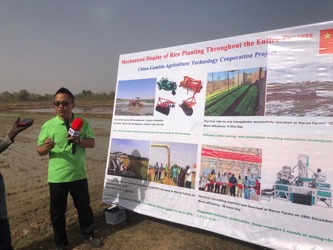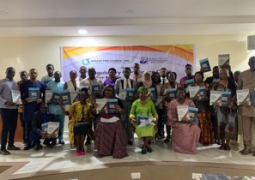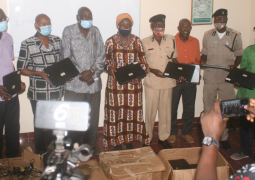
Jacky Huang was speaking on Sunday at a demonstration event of a fully mechanised rice production at its rice filed in Sapu, in the Central River Region.
Moreover, the demonstration exercise held at Sapu rice field in the Central River Region, was geared toward the promotion of high-yield cultivation technology of hybrid rice variety, (GMB LS2021)
The project, he added, is committed to rice production and other crop varieties in the country in a bid to achieve zero hunger, saying the project is working on three areas such as production of rice, vegetable and maize.
Meanwhile, the Yuan Longping High-Tech Agriculture Co. Ltd also seeks to bolster more collaboration between the Ministry of Agriculture of The Gambia and the Ministry of Commerce of China.
He disclosed that the China-Aid Project of Agricultural Technical Assistance to the Gambia (phases 1-2) has achieved the targeted objectives.
The China-aid Project of Agricultural Technical Assistance to The Gambia, implemented by the Central Project Coordinating Unit (CPCU) of the Ministry of Agriculture and Yuan Longping Agricultural High-tech Co. Ltd, is the first agricultural technical assistance project since the resumption of diplomatic relations between the two countries.
The project, he added, focuses on the local breeding and promotion of hybrid rice, thereby helping Gambians find a local method to address food security issues.
“That after four years of elaborate organisation and implementation, the project has achieved remarkable results concerning crop variety selection, technology localisation and extension, suitable agricultural machinery selection and local personnel training, etc. In particular, the high yield and stress resistance of hybrid rice impressed Gambian farmers and provided a feasible path for the Gambia to achieve ‘zero hungry.”
Already, he explained that the project has established a 7.4-hectare core demonstration area for high-yield technology at Sapu agricultural experimental station in Central River Region.
That, he said, has also carried out high-yield cultivation demonstration and supporting agricultural machinery operation demonstration for 7 local conventional rice, 8 Chinese hybrid rice and more than 40 Chinese vegetable varieties.
He also talked about standardised production processes for grains and seeds in rainy and dry seasons, which he added, have been developed based on the Gambia's climatic characteristics and irrigation practices, with emphasis on time nodes, transplanting methods, water and fertilizer management.
He disclosed that the yield of hybrid rice in the core demonstration area was 9.35 tons per hectare, which was 1.6-2 times the yield of the local conventional rice.
“The two hybrid rice varieties were selected for local registration, and 14 vegetable varieties of 7 categories suitable for local production and cultivation were selected. The project has trained more than 1,500 personnel including local farmers, agricultural technicians and college students, and a number of grassroots agricultural machinery personnel have participated in training courses, named Green Super Hybrid Rice in China.”
Read Other Articles In National News




